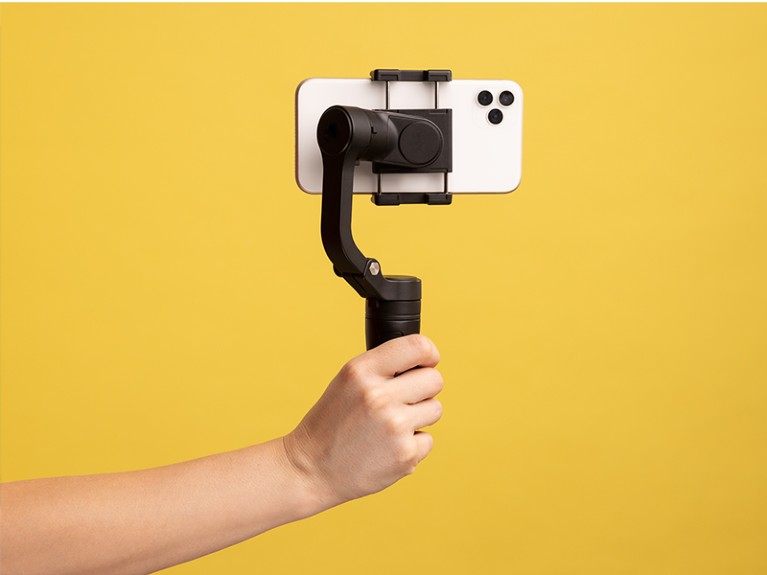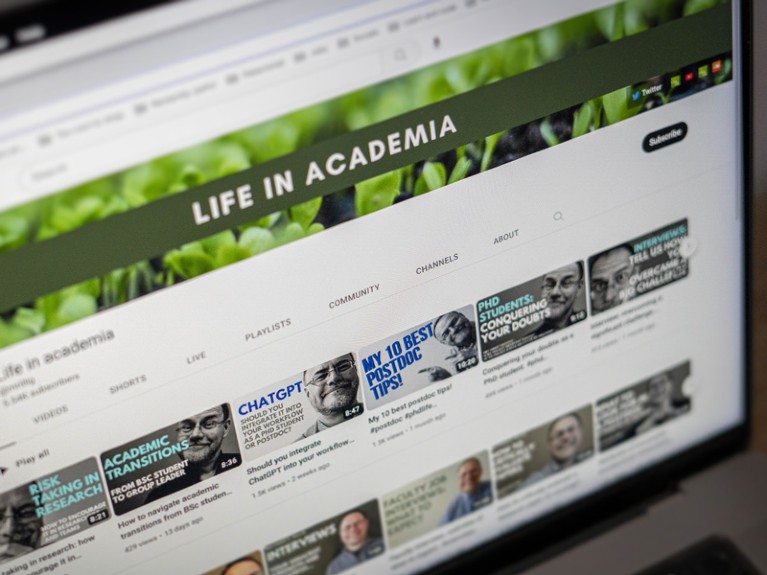
Credit: Getty
When my university asked me to record an information video for prospective students of its biodiversity master’s programme, I was nervous.
I wasn’t used to having a video camera pointed at me; when the studio lights came on, I excused myself and caught my breath in the bathroom before stepping back in front of the lens.
This was before the COVID-19 pandemic. When that was declared in March 2020, we were all forced, overnight, to become acquainted with video-calling and editing software for university teaching.
One lockdown evening after I finished recording a lecture for my soil-ecology course, I recorded myself talking about some of the research we do in my lab.
I then started producing weekly videos for my YouTube channel, called Life in Academia, and, more recently, for TikTok. In these videos I give advice for PhD students, postdocs and group leaders on how to navigate the various challenges that academia presents.
I now have more than 100 YouTube videos and I am often asked how I find the time to produce this content alongside running a research lab of more than 40 people.
The answer is that video producing is now my hobby. I enjoy the process: thinking of ideas, learning about specific research skills, taking notes for scripts, recording (I usually do this in batches of three videos), editing, and then designing thumbnails and writing descriptions and tags.
Collection: Science communication
The preparation happens on a casual basis — I note down points as I think of them, often in response to events or conversations in the lab, because the videos deal with all aspects of academic life. Topics include: interviewing for jobs, publishing, science communication and lab operations. The recording is pretty simple and quick on my mobile phone. What does take time is the editing. I do this on a weekend morning every couple of weeks.
In terms of performance, videos about the postdoctoral experience seem to do quite well, possibly because not a lot of other channels target this group (they focus mostly on PhD students). The topic that always gets the most views is interviewing for an academic job — everyone is looking for good advice here.
It’s clear that making these videos has helped me and my day-to-day work. As I’ve produced advice for others, I’ve found myself also learning a lot.
The almost-instant feedback I receive after uploading a video is perhaps one of the reasons that this has become such a big hobby. It provides an alternative to the circle of delayed gratification that academic work provides.
Often, before you get any dopamine hit from academia, you must take an idea and turn it into an experiment, execute it and analyse the results, write a paper and get it published. This takes years from conception to seeing a finished product in the form of a paper.
Matthias Rillig started the YouTube channel Life in Academia.Credit: Agnese Abrusci/Nature
Meanwhile, feedback from video creation is measured in days or hours: you can follow video views as they happen (YouTube offers a dizzying variety of real-time stats), and you get instant feedback in comments. The comments, and sometimes e-mails, almost always express appreciation, and often describe how the video helped. People also ask for more information. It all provides positive energy to take into other tasks.
But over time, I came to realize that making the videos has given me even more than that:
The research I do for my videos has already fed back into how I work. For example, I have been working on a video about note taking. The preparation I’ve done (watching other videos and reading various pieces about note taking) has made me realize how poor my own notation habits are, and I am now working on improving them. I have already acted on one point: building on notes immediately after taking them by linking them to current work. Essentially, I am more active with whatever notes I take. So rather than just writing something down that I encounter, such as a point I read in a paper, I immediately apply this idea to a current problem and produce text around it, like a nucleus for a potential paper. This has led to some publications that I am not sure would have happened otherwise. As an experienced researcher, it was a bit humbling to realize how much I could still improve.
Social media for scientists
In early 2022, I collated my experiences to record a video about how people in the team contribute to making the lab run better. I used the notes I took for this video to write a more in-depth paper, now published as a peer-reviewed article. The paper discusses how team members, including PhD students and postdocs, can improve a lab, making it a happier and more productive place. Now I try to foster such behaviour more actively.
I have the same problem everyone else does: procrastination of tasks I don’t enjoy (such as writing progress reports to grant applications). In my 2021 video about time management, I made the point that tasks typically expand to fill the time allotted to them, and so it’s important to schedule a defined block of time for them. I told myself to do a report by lunch, and it worked!
The videos have become a living library of advice for people in my lab. I think it is important to have written documents that contain important information about how the lab functions, and these are now supplemented by videos for new lab members to watch. They won’t watch all the videos when they start, but more will become relevant as they progress. For example, lab members can watch videos about manuscript revisions or how to give a job talk. These videos are structured and are based on research — they are better than what I could offer on the spot.
I feel that producing the videos has helped me build a reputation as someone who is interested in cultivating healthy lab practices. For example, some people mention the videos when applying for positions or contacting the lab.
So, yes, making these videos and releasing one every week takes time. Even though I produce them in batches — streamlining the workflow — it is still a constant commitment to take notes for an upcoming video, record it, edit it, upload it and interact with comments. But in the end, I think it is worth it. I receive a lot of positive feedback and the benefits I’ve mentioned keep me going.




